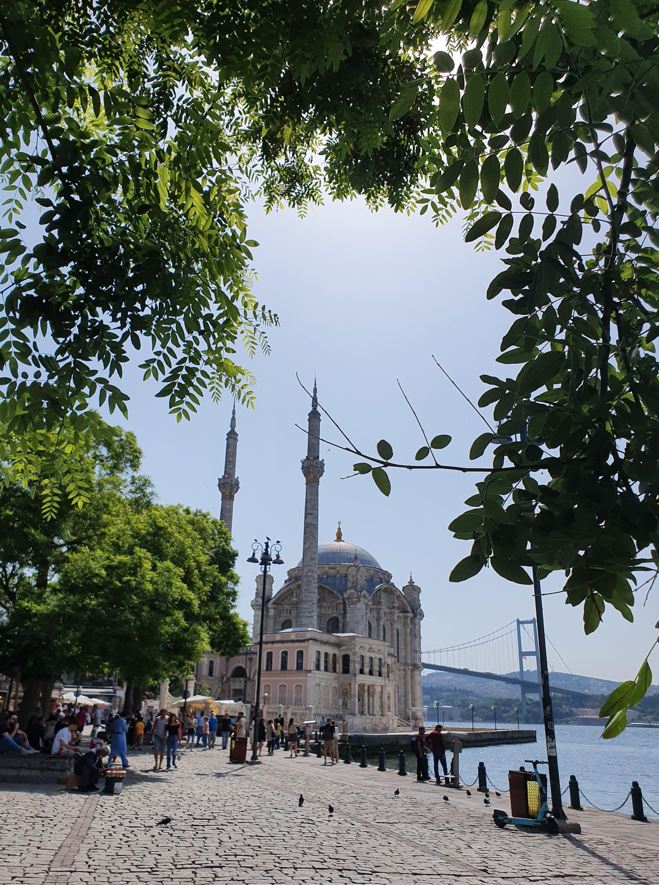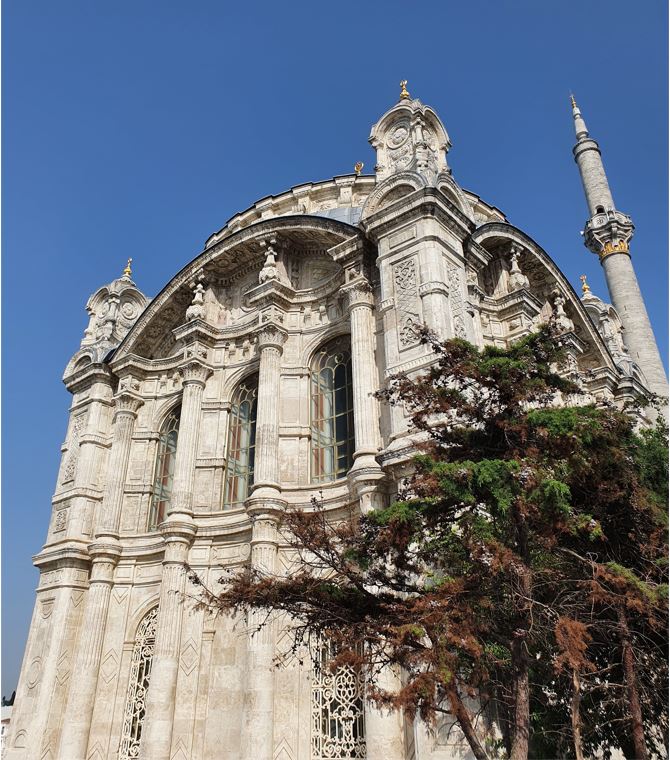Ortakoy Mosque- One of the Symbols in Istanbul
Introduction
It is a pleasure to talk about Ortakoy Mosque (also known as Grand (or Great) Mecidiye Mosque, Buyuk Mecidiye Camii in Turkish), finally. We are using a few cover photos about this mosque and its view on different platforms due to its splendid structure and silhouette including itself and the 15 July Martyrs Bridge (old name the Bosphorus Bridge, just next to the mosque). The mosque is just next to Ortakoy Square. Moreover, it is one of the symbols of Istanbul such as Galata Tower, Maiden Tower, etc. probably due to this amazing view.
In the meantime, there is always a tendency to capture beautiful photos and miss the interior structure. We definitely recommend you to visit the interior since you already come here for this view and please see this different style.
You may know that Istanbul has many great mosques such as Blue, Suleymaniye, and Yavuz Sultan Selim mosques. However, we can simply say that this design is more modern. We are sure that you will be visiting the most important ones in Istanbul and the outcome of this comparison would be concluded by your side saying “yes, this is more modern” since they represent different centuries.
Where is Ortakoy Mosque located?
You can see the location of this mosque and from a general view, it is in the center and close to many spots.
Address: Mecidiye, Mecidiye Koprusu Sk. No:1 D:1, 34347 Besiktas/Istanbul
Ortakoy Mosque- History and Structure
History
Ortakoy (middle village) was a sleepy village during the Ottoman period and at the current location of the mosque, there was a small masjid. It is thought that the old masjid had been destroyed in the 18th century during Patrona Halil Rebellion [see reference 1 for the details about the rebellion]. Sultan Abdulmecid ordered a new mosque construction around mid of the 19th century. Sultan Abdulmecid (Abdulmecit or Abdulmejid) is the major character changing the style in Istanbul which shows the modern face of the Ottomans. You may also know him from the Dolmabahce Palace as well.
He generally thought that there was bad fame in the Ottomans (especially, the phrase “sick man of Europe” was common in the 19th century) due to political and economical conditions and tried to add many good structures on the shore.
Again, the Balyan family designed this modest but modern mosque. And, it was built between 1854 to 1856 (some references also say 1853 to 1855 and some references directly point out 1853 or 1854 for the mosque opening). The capacity of the mosque can not be compared to other famous mosques but it definitely has a different style. Garabet Balyan and Nikogos Balyan were the architects of the mosque (some references say only Nikogos Balyan was the architect, check out this link about the Balyan family [2]). The Armenian family- Balyan has constructed many great buildings in Istanbul and often, it is easy to understand Balyan’s signature on the structures.
There were a few incidents (e.g. earthquake in 1894 and a fire in recent history) that damaged the mosque in history and it was also understood that the mosque was in danger of collapsing. So, there were renovation activities such as the addition of ground reinforcement. The most recent activity was between 2011 and 2014.

Structure
Exterior
The mosque does not have a big courtyard compared to other famous mosques in Istanbul. And, the mosque has a single dome and two minarets and each of them has one balcony (serefe in Turkish)
The ground is a square plan and four main columns on the corners support the structure. Right next to the mosque, there is a summer palace (or pavilion) constructed for the Sultan and attached to the mosque. Rather than having hunkar mahfili (dedicated place for Sultan in the mosque), having a pavilion-style also shows the changes over the centuries.
Basically, the mosque exterior shows three levels as you observe from the bottom till the top (the first section has two windows, the second section has three windows and the third section has the weight towers, and right after there is the dome (also check the different motifs on the columns)
At the entrance, you will observe the tughra (sultan’s signature).

Interior
A narthex is inside the mosque. One big and eight small chandeliers exist in the main area and you are very much familiar with these chandeliers from Dolmabahce Palace. Big panels having calligraphy (containing the names of Allah, the prophet Muhammed, and the first four Caliphs) are stunning and Sultan Abdulmecid also contributed to these calligraphies.
There are balconies dedicated to Sultan and women and you can go to upstairs if it is allowed (unfortunately, sometimes it is closed). Going upstairs, there is an elliptical stair. There is a sky motif on the dome opening from balcony motifs. There are different colors (pink, blue, orange, green, and more) on the walls.
Of course, there is a Mihrab showing the direction to Mecca and Minbar which uses by Imams during sermons.
Large oval windows allow the sunlight inside. The views from these windows are simply amazing. Before leaving the mosque, do not forget to take a look outside.
In addition, the interior is super clean and looks like it is cleaned frequently due to the circulation.

Ortakoy Mosque- Visiting Hours
It is not possible to check the interior during prayer time. In addition, regardless of prayer time, anyone can come and pray in the mosque. Major mosques generally have a practice about timing to accept the visitors (e.g. 9 am to 5 p.m.). However, you can’t close any mosque and it is always open to allow people to pray.
On Fridays, there is a special sermon and people together pray around noon time. So, if you are planning to go to the mosque on Friday, we recommend you to go there after 2 p.m or in the morning.
Sunset and sunrise are fascinating for the view. It is a good thing to remember for a better experience. And, if the sun is at its highest, you may be having difficulty capturing great photos.
Please also look at our post- Best time to visit Istanbul to understand the season by season experience of Istanbul.
Ortakoy Mosque- What to do around?
Ortakoy is well-known for baked potatoes (kumpir in Turkish) and waffles. You can consider trying it. There are good cafes and you can drink coffee, Turkish coffee and/or Turkish tea (e.g. Beltas next to the mosque) here. Please do not randomly pick the cafes since you may not get the quality you expect. There are also a few cafes serving shisha/hookah (nargile in Turkish) if you are interested.
There are also shops on the small streets that you can take a look for shopping. You can also see kermesses that you can check modest small pieces.
You can also consider catching a Bosphorus tour from the pier (check out this link on the Istanbul Fantasy youtube page to see what a Bosphorus tour looks like).
Other than these options, Ortakoy is close to Bebek and Arnavutkoy. The seaside is very beautiful and you can walk along the sea. Bebek region represents the luxury in Istanbul, so you can find out many good restaurants over there.
Ortakoy Mosque- Entrance Fee
If it is allowed to pray in a mosque, nobody can charge you. So, It is totally free and there is no need to have a museum pass or card. Donations are welcomed and there should be a box around where you can put some money.
Ortakoy Mosque – Dress Code
As we explained in other posts about mosques (see details in these links, Blue Mosque, Suleymaniye Mosque, and Yavuz Sultan Selim Mosque), men should cover till knee caps and women should cover their heads, shoulder, and till their feet. Make sure you are good to go inside.
How to reach Ortakoy Mosque- Quick Transportation Guide
As explained, the location of the mosque is very easy to reach. You can consider catching a taxi easily if you are on the Europen side and move to Ortakoy. Even, we sometimes prefer to walk from Besiktas to Ortakoy if the weather is not challenging. You can explore a few more good spots on the road.
Kadikoy and Uskudar
You can prefer to catch a ferry from city lines (sehir hatlari in Turkish) from Kadikoy and Uskudar and directly reach out to Ortakoy (this line could be a bit limited). However, you can still target Besiktas, and reaching out from Besiktas is easy.
Eminonu
You can consider using the funicular first to come to the Besiktas region and then follow the guideline from Besiktas to the Ortakoy region.
Taksim
You can either consider catching a taxi or bus directly to Ortakoy or target Besiktas first.
Besiktas
You can either walk, catch a taxi or catch a bus from Besiktas pier (close to Bahcesehir University).
Conclusion
Here we can simply say that this is a must-do activity in Istanbul. One way or another, please see this mosque and take a few pictures both outside and inside, if you have enough time. Even though we like exploring the gems in Istanbul, we can’t consider the idea of missing the signatures/symbols in Istanbul.
Throughout history, Istanbul saw many changes as expected. This mosque represents the western face of the Ottoman Empire like Dolmabahce Palace, Beylerbeyi Palace, etc. And, it is also obvious that the Balyan family had another signature on the seaside of this fantastic city.
Like Galata and Maiden’s Towers, Blue, Suleymaniye and Hagia Sophia Mosques, Dolmabahce Palace, and Topkapi Palace visiting Ortakoy Mosque is definitely a must-do activity in Istanbul for sure.